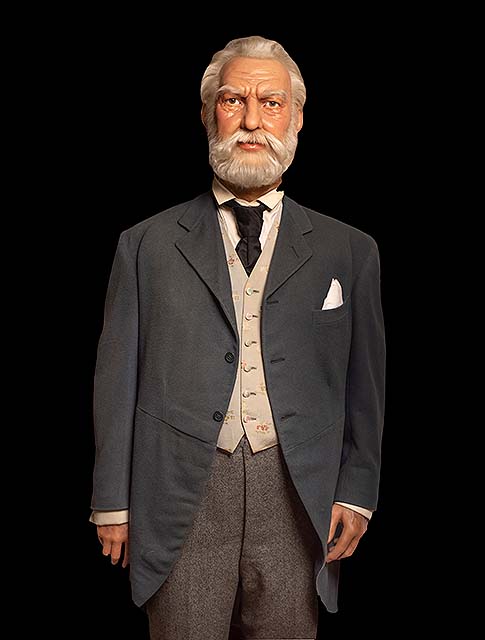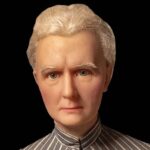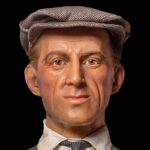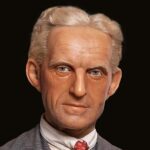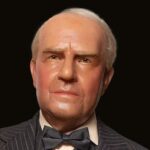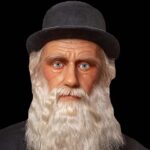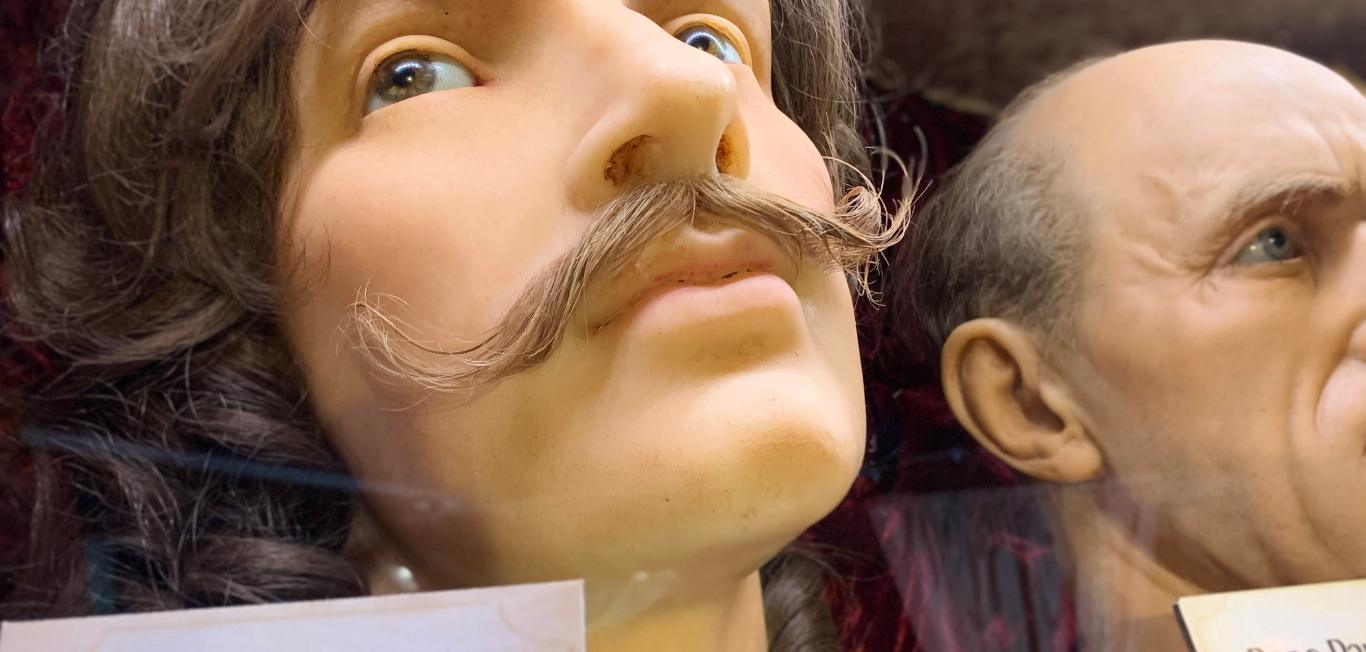History of Alexander Graham Bell
Alexander Graham Bell was born in Edinburgh, Scotland on March 3, 1847, and earned a reputation as an innovative scientist and the inventor of the telephone. His designation as an illustrious inventor gave him a lasting legacy in history and in the pursuit of modern communication.
Bell’s interest in sound and communication was evident from an early age. His father, Alexander Melville Bell, was a famous speech therapist, and his mother, Eliza Grace Symonds, was deaf. Growing up in such an environment, Bell became fascinated by the possibilities of transmitting sound.
In 1876, Bell achieved his most significant breakthrough — the invention of the telephone. This revolutionary device allowed individuals to speak to each other over long distances using electric signals. Bell’s invention paved the way for the rapid development of global communication networks, shaping the modern world as we know it.
Although it is the most notable, the telephone is not Alexander Graham Bell’s only invention. Throughout his lifetime he worked on various other projects. Bell was an integral part of photophone development, a device that transmits sound on a beam of light. The photophone laid the groundwork for the fiber optic communication we see today. Another invention Bell created was the audiometer. The audiometer is an instrument used to measure hearing acuity. This invention made significant contributions to the field of aeronautics.
Bell had a passion for helping others, particularly those with hearing impairments, which led him to establish schools for the deaf. He believed in the importance of education and dedicated his time to teaching speech and assisting those with hearing difficulties.
DID YOU KNOW?
Bell was an integral part of photophone development, a device that transmits sound on a beam of light.
Beyond his scientific endeavors, Alexander Graham Bell was an active member of society. He held a deep interest in aviation and supported the development of manned flight, providing financial assistance to inventors such as the Wright brothers.
Alexander Graham Bell’s contributions to science and society led him to receive numerous accolades throughout his lifetime. In 1877, he was awarded the Volta Prize for his invention of the telephone. Bell received several honorary degrees from universities and served as the president of the National Geographic Society.
Alexander Graham Bell passed away in 1922, leaving behind a legacy of innovation in telecommunications. He dedicated his life’s work to improving the lives of others, focusing on those with hearing impairments. Bell’s inventions created the possibility of global communication.
Interesting Facts About Alexander Graham Bell
Bell contributed advancements to the phonograph device.
Throughout his entire life, Bell demonstrated an unwavering dedication to the field of education for individuals with hearing impairments.
Bell conducted explorations and trials involving flight using aircraft that were heavier than air.
Bell constructed hydrofoil boats that possessed impressive speed capabilities.
Bell provided financial support and took on leadership roles in several well-known start-up ventures during the late 19th century.
Bell played a role in the invention of a device designed to detect metal, aiding in the search for bullets in individuals who had been shot.
Bell personally chose his own name.
Following his passing, telephone companies honored Alexander Graham Bell as a gesture of tribute.
Bell encountered a staggering number of over 600 legal cases during his lifetime.
Bell was a person who immigrated to another country.
Bell made significant contributions to the accomplishments of National Geographic Magazine.
Early Life of
Alexander Graham Bell
Alexander Graham Bell’s early life played a significant role in shaping his later achievements and contributions to the field of telecommunications. At the age of 12, Bell invented a device called the “deaf-mute” or “visible speech” machine. This machine was designed to help his mother communicate more effectively by converting visible speech into written symbols. This early invention showcased Bell’s early interest in assisting individuals with hearing impairments, a theme that would persist throughout his life.
DID YOU KNOW?
At the age of 12, Bell invented a device called the "deaf-mute" or "visible speech" machine.
In 1870, Bell immigrated with his family from Scotland, eventually settling in Boston, Massachusetts, in the United States. During his time in Boston, Bell made momentous strides in his scientific career. He worked as a teacher for the deaf at the Boston School for Deaf-Mutes. Bell’s time as a faculty member highly motivated his desire to develop technologies that would aid those with hearing impairments.
Bell’s most notable achievement came in 1876 when he invented the telephone. Working alongside his assistant, Thomas Watson, Bell successfully transmitted the first intelligible message using a device that converted sound into electrical signals and then back into sound. This breakthrough invention revolutionized communication and laid the foundation for the modern telecommunications industry.
In addition to the telephone, Bell made several other notable inventions. He developed the photophone, a device capable of transmitting sound on a beam of light, which became an early precursor to fiber optic communication. Bell’s interest in aviation also led him to experiment with aeronautical designs, including developing a tetrahedral kite and a series of manned and unmanned aircraft.
Bell’s biography serves as a testament to his innovative spirit and dedication to improving communication. His inventions, including the telephone and the photophone, continue to impact our lives today. As a founding member of the National Geographic Society, Bell encouraged scientific exploration and research. Alexander Graham Bell’s legacy as an inventor, scientist and educator remains an integral part of technological history, inspiring future generations to push the boundaries of scientific discovery and innovation.
Inventions and Accomplishments of Alexander Graham Bell
Alexander Graham Bell was a prolific inventor whose numerous creations and accomplishments revolutionized communication and left an indelible mark on the world. His inventions spanned a wide range of fields, from telecommunications to aviation and beyond, showcasing his multidisciplinary genius and relentless pursuit of innovation.
Bell’s most famous invention, and greatest achievement, was the telephone. In 1876, he successfully transmitted the first intelligible message using a device that converted sound into electrical signals and then back into sound. This groundbreaking invention forever changed the way people communicated, paving the way for the global telecommunications network we rely on today.
Building on his interest in sound and communication, Bell also invented the photophone in 1880. This device used light to transmit sound, predating modern fiber optic communication by over a century. The photophone was a significant milestone in the development of long-distance communication and played a crucial role in advancing the field of telecommunications.
Beyond his contributions to communication, Bell made notable inventions in various other areas. In the field of aviation, he conducted experiments and made significant advancements. In 1907, Bell developed the tetrahedral kite, a precursor to modern aircraft. His experiments with kites and their structures provided valuable insights into aerodynamics, laying the foundation for future aviation pioneers. Bell’s curiosity about aeronautics opened opportunities for him, such as mentoring the Wright brothers and providing monetary investments at the beginning of their flight experiment. These contributions to aviation led to advancements toward the world of aviation we know today.
DID YOU KNOW?
In 1907, Bell developed the tetrahedral kite, a precursor to modern aircraft.
Additionally, Bell invented the audiometer, an instrument used to measure hearing acuity. This invention plays a vital role in diagnosing and treating hearing impairments, furthering his commitment to helping individuals with hearing difficulties.
Bell’s accomplishments were not limited to his inventions alone. He was an active member of society, promoting scientific exploration and research. He served as the second president of the National Geographic Society and played a significant role in its growth and development.
The inventions and achievements of Alexander Graham Bell continue to shape our world. His telephone revolutionized communication, while his contributions to aviation and other fields pushed the boundaries of human ingenuity. Bell’s legacy as an inventor, scientist and educator is a testament to his unwavering curiosity, innovative spirit and dedication to improving the lives of others.
Honors and Tributes to Alexander Graham Bell
Alexander Graham Bell, an esteemed inventor and scientist, received numerous honors and tributes throughout his life in recognition of his contributions to telecommunications, education and science. These distinctions celebrated his innovative inventions, dedication to treating hearing impairments and commitment to advancing the sciences.
One of the most significant honors bestowed upon Bell was the Volta Prize in 1880. The Volta Prize was established by the Italian scientist Count Alessandro Volta. This prestigious award was given to Bell in recognition of his invention of the telephone, a groundbreaking achievement in electrical communication. The Volta Prize highlighted the global impact of Bell’s invention and cemented his status as a leading figure in the scientific community.
Alexander Graham Bell also received numerous honorary degrees from esteemed universities, further highlighting his significant improvements to science and society. Bell’s honorary degrees were awarded from institutions such as Harvard University, the University of Oxford, and the University of Edinburgh. These recognitions not only celebrated Bell’s innovative character but also acknowledged the impact his inventions have had on the world.
In addition to academic honors, Bell’s achievements have been commemorated through memberships and leadership roles at renowned scientific organizations. He was a founder and served as the second president of the National Geographic Society from 1898 to 1903, where he actively promoted scientific exploration and geographical knowledge. Bell’s association with the National Geographic Society highlighted his commitment to advancing scientific understanding and sharing knowledge with the expansive public.
Bell’s contributions to the field of education and his advocacy for individuals with hearing impairments were heavily recognized and honored. He established the Volta Laboratory Association in Washington, D.C., which became a center for research and education related to deafness. Bell’s work in this field led to the development of various devices and techniques to assist individuals with hearing difficulties. His dedication to helping those with hearing impairments earned him tributes from organizations and institutions dedicated to the advancement of education of the deaf.
The honors and tributes bestowed upon Alexander Graham Bell during his lifetime and beyond display the profound impact of his inventions and his steadfast commitment to scientific progress. Today, Bell’s name remains synonymous with innovation and discovery, and his legacy inspires future generations of inventors, scientists, and educators.
DID YOU KNOW?
Bell established the Volta Laboratory Association in Washington, D.C.
Descendants of Alexander Graham Bell
Alexander Graham Bell, the renowned inventor of the telephone, left a lasting legacy that extends beyond his own accomplishments. Through his descendants, his innovative character and contributions to society have continued to influence subsequent generations.
In 1877, Bell married Mabel Gardiner Hubbard; together they had four children. The Bell children included two sons, Robert and Edward, and two daughters, Elsie and Marian. Elsie, the oldest of the Bell children, married her father’s colleague, Gilbert Grosvenor in 1900. Much like Bell’s mother, and like her own mother, Elsie suffered from a hearing impairment. Elsie enjoyed music, and despite her disability, she went on to become an accomplished pianist.
Marian was the second child of Bell and Hubbard, and was often called Daisy. Like her mother and sister, Marian struggled with the ability to hear and underwent speech therapy and lip-reading training to help her communicate.
The third child of the Bell family was Robert. Robert was curious about the medical field and earned himself a place in the medical community as a physiologist. In this role, Robert spent a lot of time researching breathing, speech and hearing.
Edward was the youngest of the Bell children, and he suffered several ailments throughout his life. Some of the health problems Edward faced were respiratory issues and scarlet fever. Despite his ailments, Edward developed a passion for aviation and photography.
All of the Bell children lived into adulthood and made significant, innovative contributions throughout their careers. Alexander Graham Bell’s legacy lived on as his children continued to support and promote their father’s work. The Bell children focused their dedication to their father’s lifework on communication and hearing impairments.
Late in Life
On August 2, 1922, Alexander Graham Bell died, leaving behind a lasting legacy in telecommunications and science. His most notable invention was the telephone, which was patented in 1876. This device aided people in communicating over long distances by converting sound into electrical signals and then back into sound. The era of Bell’s groundbreaking achievements ended upon his passing. This revolutionary scientist’s contributions as an inventor and educator left a lasting impact on the world. His work in telecommunications and his dedication to the deaf community transformed communication and shaped the development of modern society.
Throughout his life, Bell’s curious character led to numerous progressive creations such as the telephone and photophone. In his later years, Bell remained dedicated to scientific exploration and invention. He conducted research on diverse subjects, including communication technologies, aviation, and medical advancements. He was particularly interested in aeronautics and worked on developing technologies for manned flight.
Bell was inspired by the women in his life and had a lifelong commitment to improving communication and education for those with hearing impairments. He actively supported education for the deaf and worked to advance oralism, a teaching method focused on speech and lip-reading. Bell established schools for the deaf to further his efforts.
DID YOU KNOW?
Bell was particularly interested in aeronautics and worked on developing technologies for manned flight.
In 1888, the National Geographic Society was founded. Alexander Graham Bell was a co-founder and later served as the society’s second president from 1898 to 1903. His involvement helped shape the society and its commitment to exploring and documenting the natural world.
Alexander Graham Bell’s legacy lives on through his inventions, achievements and the profound influence he had on the world. His creative and innovative mind continues to inspire generations of inventors, scientists, and individuals seeking to push the boundaries of human knowledge and improve the lives of others through groundbreaking discoveries.
FAQs
When was the telephone invented?
The telephone was invented and patented in 1876.
What did Alexander Graham Bell invent?
Bell had several inventions, including the telephone, photophone, graphophone, audiometer, metal detector, hydrofoil boat, kite designs, and the laryngoscope.
How did Alexander Graham Bell die?
Alexander Graham Bell died on August 2, 1922, from diabetes complications.
Why did Alexander Graham Bell invent the telephone?
Alexander Graham Bell invented the telephone from his desire to help those with hearing impairments and to communicate over long distances.
